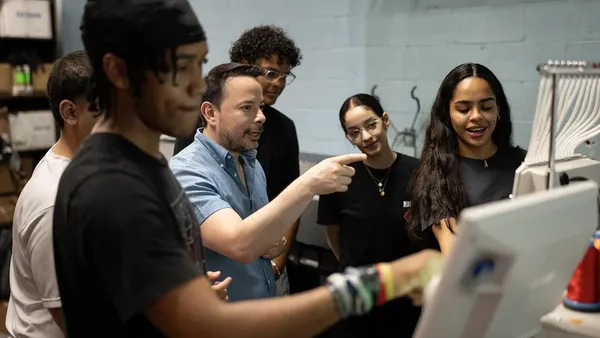Dive Brief:
- The majority of striving students (69%) said they had more fun reading a large print book than other classroom materials, according to the findings of a new national study, “Advancing Literacy With Large Print,” released jointly by Project Tomorrow and Thorndike Press, which is part of Gale, a Cengage company.
- During the study, educators wove large print copies of books into classroom activities, from reading circles to self-paced reading assignments, with 56 teachers and 1,696 students in the 3rd grade through 12th grade participating.
- Students stated they felt more positive emotional and physical affects after reading books that sported larger type, and nearly half of the students (43%) said they felt less reading anxiety when they read a book with a large print format. Additionally, if all books offered during the school year were large print, 54% of the students surveyed said they would finding reading “more enjoyable,” according to the study.
Dive Insight:
Large print books are not the typical format found in classrooms or school libraries. However, the findings from this study may signal to chief academic officers that perhaps these materials should be made available to all students, and more frequently.
Three out of four teachers in the study noted that students reading below grade level had increased their reading comprehension and retention by using large print books. But the findings of how students felt as they read large print titles are also notable: They reported having less anxiety, and feeling that their stress levels lowered.
How students feel when they’re in school can impact their learning, as a positive attitude can stimulate the part of the brain that has been associated with learning and memory.
“Over two-thirds of the teachers, including those in elementary, middle and high school classrooms, identify that the large print text increased student confidence, minimized reading distractions, and created less anxiety for their students than traditional reading text,” stated the report.
That’s a good reminder that educators and chief academic officers should focus on gathering student input before adopting new resources or learning tools for a school or district. If students prefer one format of learning over another, hearing from them on these issues is key.
It’s incumbent, then, to create opportunities where students can be heard, and administrators should look for ways to encourage the development of student voice in their districts as a result.
For schools looking to put these findings to use in material acquisition, it’s likely the study will impact classrooms that lean more on print materials than on digital devices. Not every school has access to digital books, however, nor are all titles available today in a digital format. But for those that do, it’s a simple process to increase the size of the type face on a digital handheld, whether that’s a tablet, e-book, smartphone or even a computer.
Touchscreens in particular often allow users to zoom both in and out to make type larger — and readers can also, typically, increase the font size on a page that they're reading through formatting tools.
For those schools where print is more the norm, chief academic officers should consider whether increasing the number of large print titles in classrooms may be helpful for all students. Educators must ensure that every base is covered when it comes to accounting for how students learn best, looking at all facets of their learning.
While materials and options must be available that address physical needs, tools that boost the way students feel about how they learn can be impactful as well.











